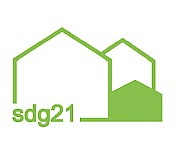Following the interim results of the Housing Summit and the Building Land Commission, demands are being voiced by the scientific community: The still tight housing markets require the use of additional instruments by the federal and state governments. Otherwise, the turnaround towards affordable housing cannot be achieved.
Berlin/Düsseldorf/Mannheim. In view of the continuing undersupply of affordable housing, researchers from the University of Mannheim, the Macroeconomic Policy Institute of the Hans Böckler Foundation (IMK) and the German Institute of Urban Affairs (Difu) are calling on the federal government to set up a participation fund for municipal housing companies and better framework conditions for the establishment of municipal land funds.
According to Sebastian Dullien, Scientific Director of the IMK, there is no sign that the housing situation in the metropolitan areas and their surrounding areas will ease as a result of the Corona crisis. "The declining capacity utilisation in the construction sector makes increased public housing construction also sensible in terms of economic policy. It is an opportunity that additional construction demand no longer inevitably leads to higher prices," says Dullien. "Public housing construction is not only an important pillar of the economy, it also has far-reaching social, economic and ecological effects in the long term. The housing shortage in metropolitan areas is forcing people with low and medium incomes out of attractive urban locations, thus leading to segregation that can endanger the cohesion of society," adds Ricarda Pätzold, housing market expert at Difu.
A participation fund of the federal government, which should be handled by the Kreditanstalt für Wiederaufbau, should strengthen the equity base of municipal housing companies. "A higher equity ratio strengthens the refinancing and investment capacity for the new construction of affordable housing, for those enterprises where this is currently a restriction. One advantage of this instrument is that the equity fund - in contrast to earlier programmes - can focus its support specifically on those housing companies that create affordable housing in tight markets," says Tom Krebs, Professor of Economics at the University of Mannheim.
The availability of land is currently proving to be the "bottleneck" in almost all fields of urban development - housing construction, commercial development, social infrastructure, etc. The availability of land is a key instrument of public welfare-oriented housing policy. Municipal land funds are central instruments of public welfare-oriented housing policy. Arno Bunzel, head of the research department Urban Development, Law and Social Affairs at Difu, clarifies: "Municipal land funds are central instruments of housing policy oriented towards the common good. We must therefore improve their effectiveness. The federal government and the Länder should contribute their land for which they have no own use to the respective municipal land funds. In this context, the provisions in the federal government's Land Subsidisation Directive must be further developed from an urban development perspective." The financial situation of the municipalities must be described as the main obstacle to the implementation of viable land funds. "The federal states should design the budgetary and municipal supervisory regulations for their municipalities in such a way that municipal land funds have adequate refinancing conditions that are based on economic criteria and not on traditional cameral budgetary law," says Carsten Kühl, Institute Director of Difu.
Details and download
Policy Paper "Participation Funds and Land Funds to Strengthen Public and Affordable Housing".
www.difu.de/15780
Authors of the policy paper:
Prof. Dr Sebastian Dullien, Macroeconomic Policy Institute of the Hans Böckler Foundation
Prof. Dr Tom Krebs, University of Mannheim
Prof. Dr. Arno Bunzel, Prof. Dr. Carsten Kühl and Dipl.-Ing. Ricarda Pätzold from the German Institute of Urban Affairs (Difu)
Short info: German Institute of Urban Affairs
As the largest urban research institute in the German-speaking world, the German Institute of Urban Affairs (Difu) is the research, training and information institution for cities, municipal associations and planning communities. Whether urban and regional development, municipal economy, urban planning, social issues, environment, transport, culture, law, administrative issues or municipal finance: Founded in 1973, the independent Berlin-based institute - with a further location in Cologne - deals with an extensive range of topics and, on a scientific level, deals in a practical way with all the tasks that municipalities have to deal with today and in the future. The Verein für Kommunalwissenschaften e.V. is the sole shareholder of the research institute, which is run as a non-profit limited company.
Keywords:
Soil & land consumption, DE-News, Communities, Affordable housing, Housing, Housing policy




